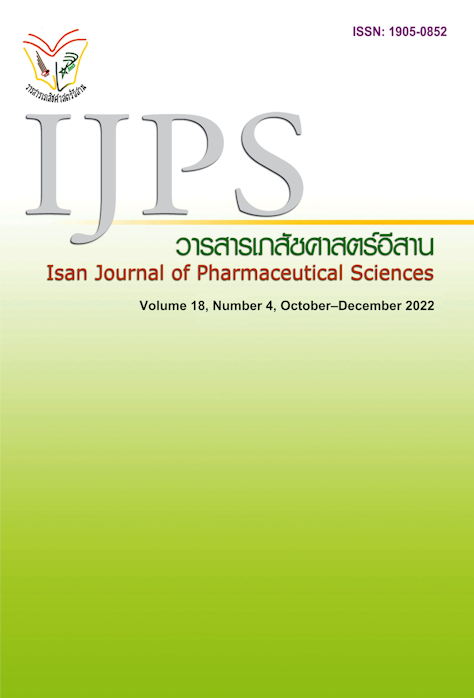Perceptions, Attitudes and Experience toward Telepharmacy Service among Community Pharmacists: A Qualitative Study
Main Article Content
Abstract
Telepharmacy is a novel pharmaceutical care service. Pharmacist can communicate with patients or clients through telecommunication technology. This study aimed to explore community pharmacists' perceptions, attitudes, and experiences toward telepharmacy service. Methods: This study was qualitative research that collected data from 24 community pharmacists working at drugstores in all regions of Thailand. The data was gathered from 3 online-focus groups discussion (7 to 9 pharmacists per group), and data analysis was conducted using content analysis. Results: The majority of participants were female (54.17%), with the average age of 30.65 ± 3.71 years. Most were business owners (66.67%). The participants were classified into 2 groups: partly-telepharmacy and full-telepharmacy. Both groups provided different perceptions about standards and procedures for telepharmacy of the pharmacy council of Thailand. Partly-telepharmacy group perceived that the standards and procedures had not been a mandatory practice. In terms of attitudes, they considered that the standards and procedures are rather too complicated but full-telepharmacy group perceived important and good attitudes toward standards and procedures for telepharmacy of the pharmacy council of Thailand. For experience aspects, both groups provided similar telepharmacy services, such as patient interviews and drug dispensing, as well as services related to the COVID-19 pandemic and smoking cessation. However, in some aspects telepharmacy service procedures of both groups were different; partly-telepharmacy group has limitations on patient registration and audio/video records while providing services due to a lack of suitable technology. Conclusions: Both groups provided different perceptions about standards and procedures for telepharmacy of the pharmacy council of Thailand. Partly-telepharmacy group had an incorrect perception of standards and procedures for telepharmacy from the pharmacy council of Thailand. They considered that the standards and procedures were rather too complicated. On the contrary, full-telepharmacy group had a correct perception and positive attitudes toward the telepharmacy. As a result, the two groups had different experiences with telepharmacy services.
Article Details

This work is licensed under a Creative Commons Attribution-NonCommercial-NoDerivatives 4.0 International License.
In the case that some parts are used by others The author must Confirm that obtaining permission to use some of the original authors. And must attach evidence That the permission has been included
References
Biruk K, Abetu E. Knowledge and Attitude of Health Professionals toward Telemedicine in Resource-Limited Settings: A Cross-Sectional Study in North West Ethiopia. J Healthc Eng 2018;2018:2389268.
Canadian society of Hospital pharmacists. Telepharmacy: Guideline [Online]. 2018 [cited 2021 Jul 6]. Available from: https://www.telemedecine-360.com/wp-content/uploads/2019/03/2018-CSHP-Telepharmacy-Guidelines.pdf.
Davis FD. Perceived usefulness, perceived ease of use, and user acceptance of information technology. MIS quarterly 1989:319-40.
Gaiser TJ. Online focus groups. In: Fielding NG, Lee RM, Blank G, editors. The SAGE handbook of online research methods. London: Sage;2008:290-306.
Health Sciences authority. Guidance Notes On Supply Of Registered Therapeutic Products Through E-Pharmacy [Online]. 2020 [cited 2021 Jul 6]. Available from: ttps://www.hsa.gov.sg/docs/default-source/hprg-ald/guide-mqa-032.pdf.
Lampang V. Development of telepharmacy effected to new normal pharmaceutical care services in Thailand [Independent study]. Bangkok: Mahidol University; 2021.
Lertsinudom S. Telehealth Region 7 [Online]. 2021 Mar 29 [cited 2022 Sep 19]. Available from:
https://www.telehealthregion7.com/assets/files/manual/User_Manual_Officer2.pdf
Muflih SM, Al-Azzam S, Abuhammad S, Jaradat SK, Karasneh R, Shawaqfeh MS. Pharmacists' experience, competence and perception of telepharmacy technology in response to COVID-19. Int J Clin Pract 2021:1-9.
Nguyen M, Fujioka J, Wentlandt K, Onabajo N, Wong I, Bhatia RS, et al. Using the technology acceptance model to explore health provider and administrator perceptions of the usefulness and ease of using technology in palliative care. BMC Palliat Care 2020;19(1):138.
Patel SY, Mehrotra A, Huskamp HA, Uscher-Pines L, Ganguli I, Barnett ML. Trends in outpatient care delivery and telemedicine during the COVID-19 pandemic in the US. JAMA Intern Med 2021;181(3):388-91.
The Pharmacy Council of Thailand. Standard and developing telepharmacy. Statement of Pharmacy Council (56/2563). 2021 Jun 25.
Thomyamongkon A, Sitthiworanan C. Use of Social Media for Providing Health Care Services by Community Pharmacists in Bangkok. Thai Journal of Pharmacy practice 2019;9(1):39-52.
Wang L, Wang Y, Ye D, Liu Q. Review of the 2019 novel coronavirus (SARS-CoV-2) based on current evidence. Int J Antimicrob Agents 2020;55(6):1-6.
Wattanathum K, Dhippayom T, Fuangchan A. Types of Activities and Outcomes of Telepharmacy: A Review Article. IJPS 2021;17(3):1-15.


